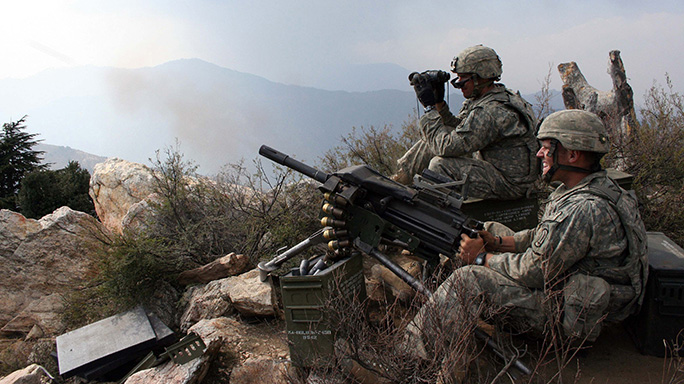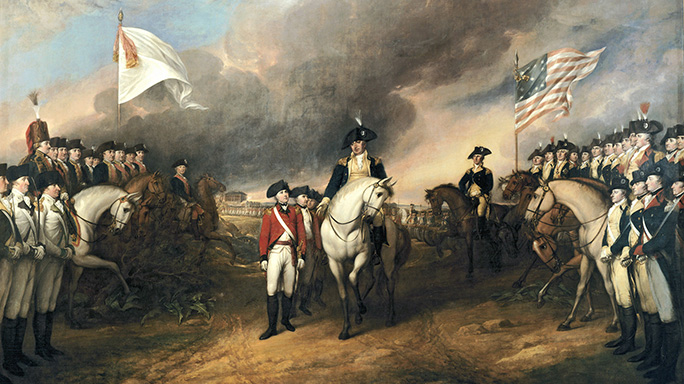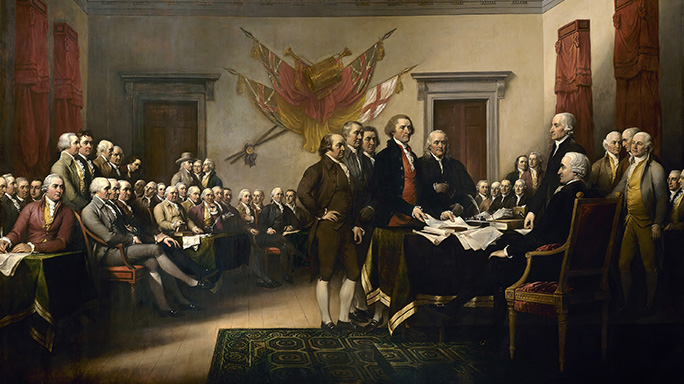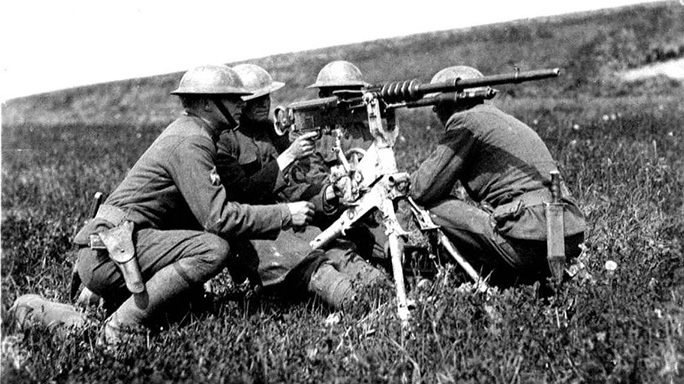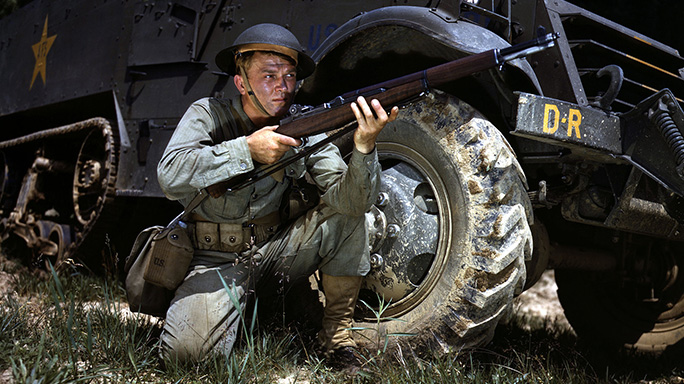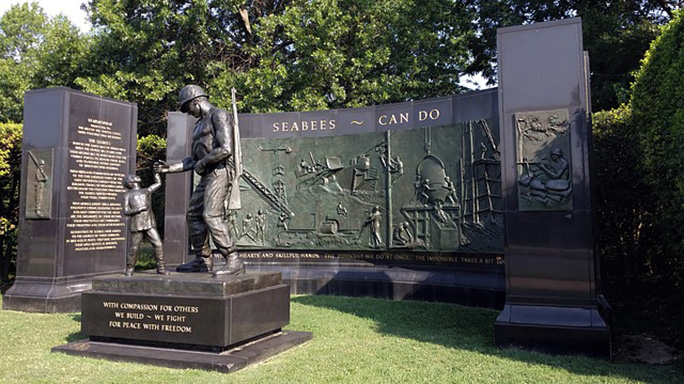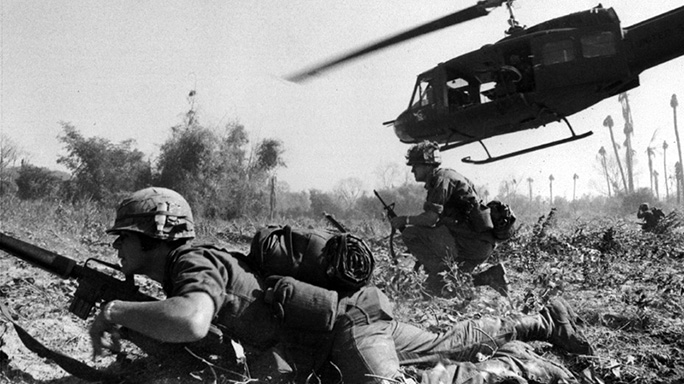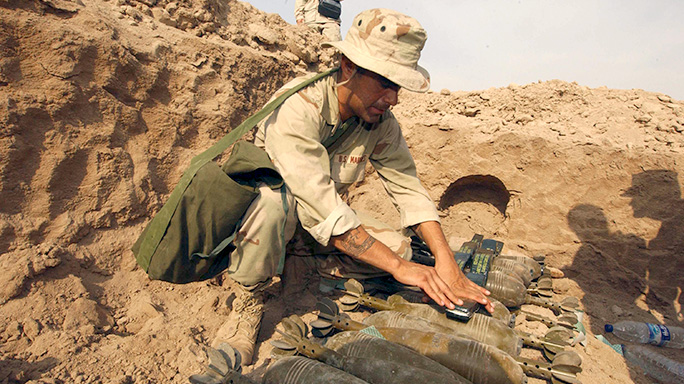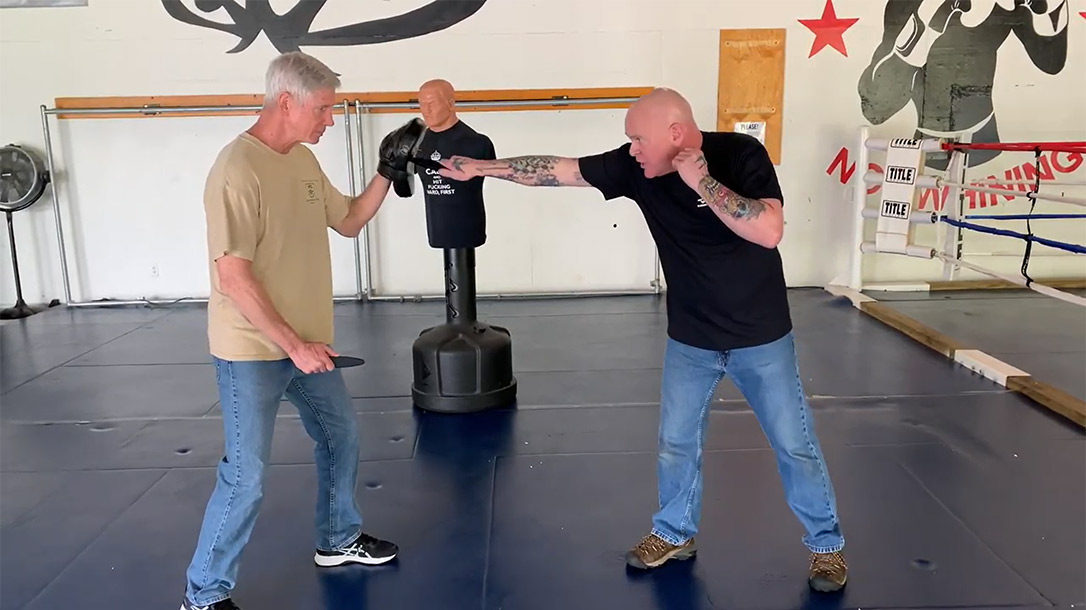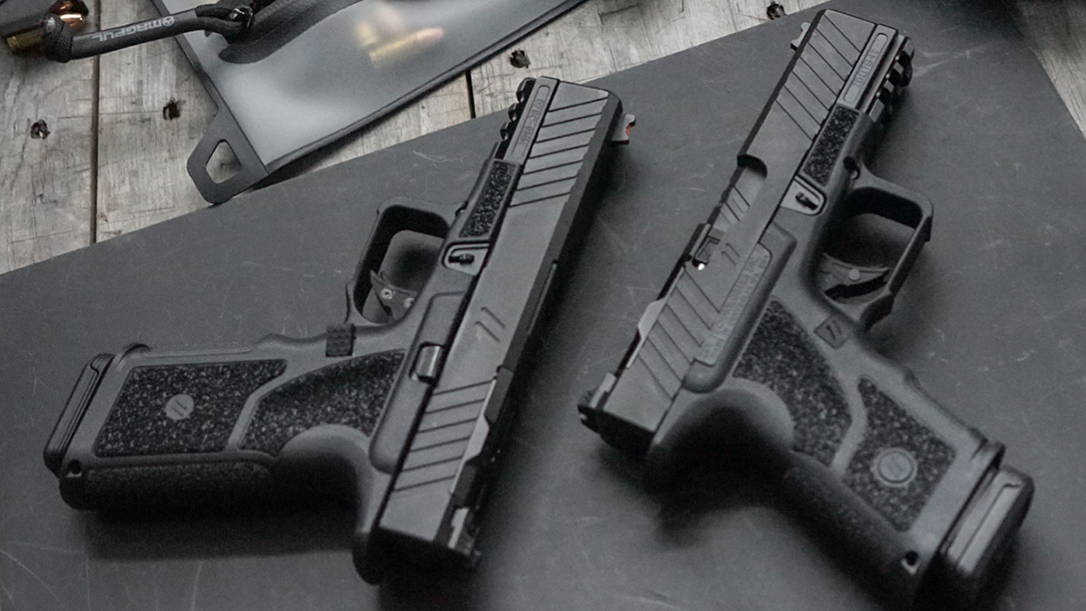It might be simple to start chronologically to share the history of the United States of America’s military history and chronicle our victories and tout the heroics of famous generals and admirals, but that would fall short. A true presentation of the history of America’s armed forces should honor the individual sacrifice of so many men and women as America was born and struggled for survival. Then, when she got on her feet and sought to lend a helping hand, the soldier and sailor were there to serve their country. And when we were under attack, one man and one woman at a time stepped forward to defend our nation.
- RELATED STORY: Honoring Our Veterans on Veterans Day
Studying the history of the United States’ military branches tells us that in times of peace the powers that be worked hard at downsizing and deemphasizing military procurement and development. Our founding fathers sought to keep the nation’s military in check and a land of populace rule, so that military growth and change during peace time took a back seat. On the other hand, during times of war, our military underwent dramatic leaps in troop numbers and technology. It is for this reason that we mark our military histories during times of war.
Revolutionary Roots
Prior to the outbreak of the American Revolution, the original 13 colonies relied upon local militia regiments and the British for their defense. Although the British allowed some localized self-governance among the colonies, many of the colonists felt they did not receive equal (or any) representation in parliament compared to the high taxes forced upon them. After the British parliament continued to raise taxes on the colonies, protests and boycotts broke out. In response, Britain continued to raise taxes and impose more laws and regulations on the colonists. Tensions began to rise, and on March 5, 1770, British soldiers fired on an unruly mob of rebels, killing five. This is known as the “Boston Massacre.” The Brits would not back down and continued to raise new taxes, specifically on imported goods. This led to what we now know as “The Boston Tea Party” after colonists destroyed a British shipment of tea in the Boston harbor.
By February of 1775, the British decided to disarm the Patriots and imprison any who would challenge the Crown. These protests finally reached a boiling point at Concord and Lexington, where British General Thomas Gage attempted to ride to Concord and capture the militia’s munition supply. When the colonists gathered intelligence and found out General Gage’s plan, the famed Paul Revere and others rode to Concord and Lexington and alerted the Minutemen that the British were coming. Here, on April 19, 1775, the first shots of the Revolution rang out between the British regulars and the Patriots. Due to the quickness and tactics of the Minutemen and militia, the Patriots were able to fight off the British and send them into a retreat.
The Minutemen and militia utilized guerrilla-style warfare and ambushes as they drove the British out of their territory. This was a pivotal moment in U.S. military history, as these tactics were not readily used by other military forces of the day. Many of the Minutemen and militia were veterans of the French and Indian War, where they learned unconventional, yet valuable tactics. These tactics would lay the foundation for U.S. military victories throughout the war.
Shortly after these battles, the Second Continental Congress established the official, standing Continental Army on June 14, 1775. This united many of the militias, Minutemen, and volunteers in all the colonies into a single unit against the occupying British forces. This Continental Army, however, was barely an army at all. Most were untrained, volunteer citizen soldiers with few supplies or weapons. The British had the largest and most powerful army and navy in the world at the time. They would need an incredible leader to lead the fight against seemingly insurmountable odds. General George Washington was appointed commander-in-chief of the military for the duration of the war, although he never accepted any monetary compensation for his service.
Under Washington’s leadership, the Continental Army created supply chains, coordinated logistics, established training regimens and developed allies. Washington originally organized the Continental Army into three divisions with six brigades and 38 regiments. Victory would not come easy in this war. Washington and the Continental Army suffered many defeats and the war effort eventually sent the Continental Congress into bankruptcy. Nevertheless, the Patriots relentlessly fought on, many as volunteers and with few supplies.
By capturing valuable supplies from the enemy, forging some of their own weaponry and gaining the French as an ally, the Continental Army was able to repel many attacks and score key victories. After signing the Declaration of Independence on July 4, 1776, the colonial revolutionaries were no longer colonists, but now Americans in an official United States. At this time, Washington’s army had roughly 20,000 men, including the militias. The Continental Army, now united under 13 states, continued to muster its forces and gained major victories in Trenton and Princeton, New Jersey, and then in Saratoga, New York. As the war ventured south, the Continental Army and French allies finally defeated the British at Yorktown, Virginia on October 19, 1781. Soon after, the British realized they no longer had any chance of achieving a victory and signed the Treaty of Paris on September 3, 1783, officially ending the war.
The American Revolutionary War lasted from 1775 to 1783. The Continental Army, however, was not the official United States Army we know today. Soon after the Revolutionary War ended, Congress enacted several reorganizations and restructurings, disbanding many of the regiments and reverting to local militias. After some prodding from General George Washington, Congress finally passed legislation on September 29, 1789, creating an official U.S. military, including the United States Army. Today, the U.S. Army still celebrates its birthday on June 14, 1775.
A National Force
A variety of events triggered the outbreak of the War of 1812. Along with the bitterness still in the air from the Revolutionary War, commerce and trade among the nations was strained as Britain had been at war with Napoleon’s France. In attempts to weaken each other’s economy and supply chains, Britain tried to halt French trade with the United States, and, in the same fashion, France tried to halt British trade. The British also engaged in what was called impressment, where the British Navy took over U.S. merchant ships and forced the occupants into working for the British. In addition, the British continually worked with and encouraged Native Americans to attack the states. The United States officially declared war with Britain on June 18, 1812.
Originally, the founders did not want to create a large, full-scale military for fear of establishing a dictatorship. However, as the wars with Britain continued, they realized the need for a large, national military rather than relying too heavily on state militias. At the onset of the War of 1812, the U.S. Army had roughly 7,000 troops. By the end of the war, the numbers jumped to more than 35,000. During this war, the Regular Army included the 1st through 46th Infantry, the 1st through 3rd Artillery, the Corps of Artillery, 1st and 3rd Rifle Regiments and the Light Dragoon Regiment. Even though the Regular Army was growing, they lacked a unified training regimen as many came from separate state militias. The War of 1812 shed much-needed light on some of the deficiencies in professional training of the U. S. Army. Leadership and training, specifically among officers, became a priority.
On Christmas eve, 1814, the Treaty of Ghent was signed, thus officially ending the war. This, however, was not the end of the conflict. Unaware of the signed treaty, British forces attacked U.S. forces in New Orleans, but they were met with an abrupt defeat by the U.S. Army under the command of future president Andrew Jackson. This war was a turning point in U. S. Army history and paved the way for a strong, well-trained and patriotic Army for generations to come.
Expanding Borders
After the War of 1812, the United States focused on westward expansion. The U.S. Army’s primary objective was to protect this expansion progress and deal with the many warring Native American tribes to the west. Another main objective for the Army was to protect the coastal seaports, specifically with artillery units. In this era, the Army Corps of Engineers took control of river navigation, mainly on the Ohio, Mississippi and Missouri rivers. Here, the Army expanded the use of steamboats and paddleboats to gain access to the west.
Throughout the first part of the 19th century, the U. S. Army was heavily engaged in battles with Native American tribes. They fought three Seminole Wars with the Seminole tribe in Florida. The first Seminole War was from 1814 to 1819, the second from 1835 to 1842 and the third from 1855 to 1858.
Further south, a major conflict was brewing in Texas. After Sam Houston and the Texians defeated Mexico’s General Santa Anna at the Battle of San Jacinto, Texas became the 28th state after the U. S. annexation of Texas in 1845. Nevertheless, Mexico would not relinquish control of Texas and still made claim to the land. In 1846, the Mexican-American War began. At the start of the war, the U.S. Army only numbered 8,613 soldiers. Recruitment was low and the numbers were well below what Congress had authorized. Congress and President James K. Polk began enlistment campaigns to raise the numbers of the Regular Army and volunteers. By the end of the war, the U.S. Army grew tremendously and more than 100,000 Americans served in the military during this war.
The Mexican-American war also gave rise to the new percussion cap firearms. This type of weapon was far more reliable than the old flintlocks. Some manufacturers began to rifle the barrels in the new firearms. Although few of these rifles were used in this conflict, it showed the usefulness of a more accurate shooting long gun. Famously, Samuel Colt invented his revolver a few years prior and the U.S. government purchased 1,000 for use in the Mexican-American War.
Generals Zachary Taylor and Winfield Scott were in charge of the main assault into Texas and Mexico. Part of the campaign also included taking control of California, New Mexico, Nevada, Utah, and parts of other western territories. The United States lost very few battles in this war and by the end of the war in 1848, the United States had achieved all of its goals for westward expansion.
The Great War
On April 6, 1917, the United States declared war on Germany, officially entering World War I. The U.S. attempted many peace talks for three years before entering the Great War, but it seemed the Germans were set on pulling America into the war. After German U-boats continued to attack passenger vessels, killing many U.S citizens on board, Americans had nearly had enough. The Zimmerman note was the final straw. In this telegram, intercepted by the British, Germany made a plea to Mexico to unite against the United States. Germany enticed Mexico by saying they would give funding and help them take back territories in Texas, Arizona and New Mexico. President Woodrow Wilson and Congress were forced to declare war.
The U.S. Army was severely undermanned for this type of large-scale war. Congress created what was called the National Army, consisting of a volunteer army and drafted conscriptions. The Selective Service Act soon passed and raised the Regular Army to a force of 286,000. This act also expanded the National Guard to more than 450,000 and a National Army of up to 1,000,000. The numbers continued to increase and by the end of the war, an estimated 2 million U.S. troops served in the European theater.
World War I brought offered new technologies and challenges to the U.S. Army. For the first time, aircraft, tanks, machine guns and poison gas were used on the battlefield. Advanced artillery, flamethrowers and mortars were also introduced. The Army began using smaller units, rather than sending in full companies into battle. Squad-sized elements provided a more tight-knit group, led by a non-commissioned officer (NCO) capable of making quick decisions in this new wartime environment. The newly industrialized United States provided faster production and massive amounts of combat equipment needed for the war effort, including tanks, aircraft, firearms, armored vehicles and many other necessities.
The U.S. Army quickly adapted to new types of warfare introduced in this theater. Troops could now gather intelligence from aircraft and newly developed radios with wireless communication. With the introduction of land vehicles, tanks and aircraft, the Army continuously grew into new divisions to utilize these new technologies.
The end of the war came quickly. U.S. and French forces eventually forced Germany into signing an armistice, thus ending the war on November 11, 1918. The Army learned many valuable lessons in this war that would help sustain U.S. defenses well into the next century.
Against The Axis
Much debate exists on the exact date World War II began, but the most common reference is September 1, 1939, when Germany invaded Poland. As all of the world’s leading superpowers were at war at the time, the U.S. Army realized the need to increase its readiness and manpower. In 1939, the Army ranks stood at 189,839 troops, even though the National Defense Act of 1920 allowed for 280,000. After the formation of the Axis powers, including Germany, Italy and Japan, Congress appropriated the funds needed to raise a much larger military. As Nazi Germany, under the control of Adolf Hitler, grew more powerful and ruthless, it was clear this would not be a short-lived campaign.
As word of the atrocities of the Holocaust reached around the globe, the Unites States was posed to soon enter into war. By the middle of 1940, the War Department increased the Army to more than 1.5 million while calling the reserves and making the National Guard a federal division capable of overseas deployment. For the first time, Congress enacted the Selective Service during peacetime to further increase military numbers.
On December 7, 1941, the Japanese attacked Pearl Harbor, Hawaii, and the United States officially entered the war. Realizing the need for a much larger military, Army Chief of Staff General George C. Marshall continued a massive expansion of personnel and weaponry, utilizing every resource available. The Army had to fight in nearly every corner of the globe, launching campaigns throughout the Pacific, Europe, Africa, the Middle East and other blanket campaigns. In all, the Army fought in 44 major campaigns during the war.
Some of the most famous battles in history occurred during this war. From D-Day in Normandy to Guadalcanal, the Philippines and the Po Valley, the U.S. Army proved victorious against insurmountable odds. The total number of U.S. Army troops totaled nearly 8.3 million by the end of the war. After the Battle of the Bulge and the Alsace campaign, Germany finally surrendered in May of 1945. After the United States dropped atomic bombs on Hiroshima and Nagasaki, Japan, the Japanese surrendered on August 15, 1945.
From Korea To The Cold War
At the end of World War II, the Allies agreed that Japan would relinquish all of its colonies, including Korea. The State Department divided Korea in half along the 38th parallel. The United States took responsibility for the southern half and the Soviet Union took responsibility for the northern half. This later proved to be a mistake, as the northern half became a communist regime supported by communist China and the Soviet Union.
On June 25, 1950, the communist-backed North Korea invaded South Korea. The United Nations Security Council sent in troops to stop the advance of the communists. The U.S. was concerned that if the communists in Korea were successful, then the communists in China would be emboldened and attempt to spread into other parts of the world. General Douglas MacArthur was in charge of the operation and led amphibious landings and invasions to cut off the North Korean advances. Eight U.S. Army divisions deployed in Korea, including the 1st Cavalry, the 2nd, the 3rd, the 7th, the 24th, the 25th, the 40th and the 45th Infantry, and the 5th, 29th, and 187th RCTs. The Army, under General MacArthur, was successful in pushing the North Koreans back, all the way to the Chinese boarder. However, China sent in troops to North Korea and forced the UN and U.S. troops to retreat into South Korea.
Most of the fighting occurred during the first year of the war. Both sides continued fighting over the boundaries but with little success on either side. An armistice was finally reached on July 27, 1953, but this did not unify Korea. Today, North and South Korea are still technically at war and in a cease-fire.
This was a very delicate situation as the Soviet Union financed and armed the North Koreans and the Chinese against the South Koreans and the United States. This could have quickly developed into World War III. Actions in the region and tensions with the communists quickly led further into the Cold War era—the time just after World War II until roughly 1991 with tensions between NATO and Soviet allies. The U.S. Army remained strong during this time while restructuring the division organizations.
Modern Combat
After World War II, the Unite States left strategically placed military personnel in the Vietnam region. The threat of communism was at an all-time high, specifically in Southeast Asia. Despite the war in Korea, the communists were still in power. Most of Asia continued to be a hotbed of communist influence, spearheaded by communist China and the Soviets.
Most of the Army personnel in Vietnam operated in intelligence and advisory roles until 1965, when the United States deployed a significant number of combat units. This was the first time the U.S. Army employed helicopters on a large scale. This introduced the Air Cavalry units that flew the famed Huey, Chinook and Cobra helicopters. The fixed-wing aircraft of the day were nearly all jet powered and weapons systems were rapidly advancing. The Army was now using advanced radar systems and guided missiles. All of this technology required constant evolution in training and tactics.
During this Cold War era, clandestine intelligence operations increased and led to the development of special operations units. The U.S. Army utilized many of these special operations and intelligence units during Vietnam, which helped develop the modern operating units of today.
With the end of America’s role in the Vietnam War, the draft was suspended and the Total Force Policy enacted to help better integrate the reserve components with the Regular Army. Even though this marked the end of the war in Vietnam, the Army remained on alert as tensions with the Soviets and China continued for many years.
The next large-scale Army campaign arose in August of 1990 with the Gulf War. The U.S. Army was in the process of downsizing after the fall of the Berlin Wall and after what appeared to be the end of the Cold War. As tensions arose in the Middle East, the Army quickly redirected its training and operations to the desert environments of Kuwait and Iraq.
After Saddam Hussein invaded Kuwait, the U.S. deployed a massive amount of manpower and weaponry in what some say was the fastest deployment buildup in history. The Iraqi army numbered nearly 1 million men with brigades of tanks, artillery and air support. The U.S. quickly destroyed most of Iraq’s defensive systems with air campaigns and bombing raids. The Army utilized M1 Abrams tanks, heavy artillery and Apache helicopters to eliminate Iraq’s Republican Guard. This war made use of new technologies such as global positioning systems (GPS), advanced missile guidance systems and other computer-based systems not previously seen in combat. This short-lived war was over by February of 1991, after coalition forces destroyed much of Saddam’s military power.
The U.S. Army would see action in the Middle East again after the terrorist attacks on September 11, 2001. The Department of Defense quickly deployed troops into Afghanistan to pursue the terrorist threat and later led a full-scale invasion of Iraq in 2003. Saddam’s regime quickly fell, but the war effort was just beginning as terrorist organizations poured into Iraq and Afghanistan to combat U.S. troops. U.S. Army personnel have been embedded throughout Iraq, Afghanistan and parts of Pakistan fighting the war on terror. Throughout this war, the Army has gained long-term combat experience that has dramatically changed and improved modern warfare and tactics.











